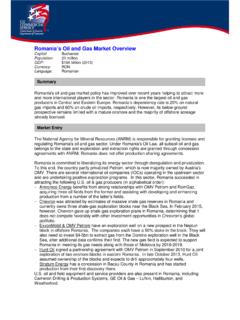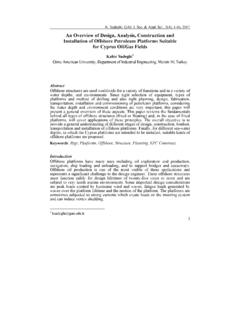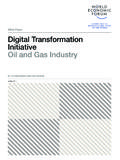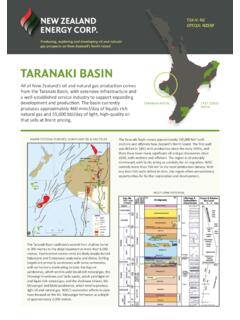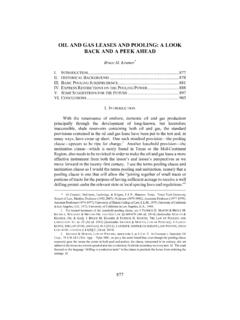Transcription of Natural Gas Discoveries in the Eastern Mediterranean
1 Natural Gas Discoveries in the Eastern Mediterranean Michael Ratner Acting Section Research Manager August 15, 2016 Congressional Research Service 7-5700 R44591 Natural Gas Discoveries in the Eastern Mediterranean Congressional Research Service Summary Since 2009, a series of large Natural gas Discoveries in the Levant Basin have altered the dynamics of the Eastern Mediterranean region. Israel s discovery of the Tamar Field and subsequent discovery of the larger Leviathan Field created the potential for the country to become a regional player in the Natural gas market. Since the initial Israeli Discoveries , Cyprus and Egypt have also found new gas deposits in the Mediterranean . The Aphrodite Field was discovered by firm Noble Energy in Cypriot waters in late 2011 and the massive Zohr Field was found in Egyptian waters by Italian firm Eni in Discoveries create the potential for Cyprus to export gas and for Egypt to meet more of its domestic gas needs.
2 Lebanon has not yet discovered recoverable gas reserves, but geologic data indicates that there is the potential for Lebanon to possess significant gas resources. Israeli gas Discoveries have been contested by Lebanon, which disputes an area of about 300 square miles along the countries unsettled maritime border. The Administration has sought to mediate the maritime dispute between Israel and Lebanon. New gas reserves could change how energy is used in the region. Since the Tamar find, Israel s electricity energy mix has begun to shift from oil to Natural gas-fired power plants. Gas-fired plants emit less carbon than oil-fired plants, and continuing to convert oil plants could help Israel meet long-term carbon emissions goals. The development of gas infrastructure in Cyprus could also help the country transition from oil to gas-fired power generation.
3 A similar shift could also occur in Lebanon should gas be discovered and related infrastructure developed. Lebanon currently uses no Natural gas. Israel now has the potential to become a gas exporter. There are a number of potential buyers for Israeli gas. Egypt, currently facing an energy crisis, will need to import gas to cover domestic demand in the near future. While Israeli gas imports are politically unpopular in Egypt, private Egyptian firms have already begun to negotiate agreements with Noble Energy to import Israeli gas. Jordan is another possible destination for Israeli gas. Repeated attacks on Egypt s Arab Gas Pipeline have decreased Jordan s energy security and increased the need for it to find alternate, reliable sources of gas. Finally, recent progress on improving diplomatic relations has opened the possibility of Israeli gas exports to Turkey.
4 These exports could either be shipped by the construction of a direct pipeline or by liquefied Natural gas (LNG) tankers crossing the Mediterranean . Although the United States is essentially independent in its Natural gas resources, it has expressed interest in the Eastern Mediterranean Natural gas resources, particularly in the development of Israel s resources. Congress and the Obama Administration have undertaken a variety of efforts in regard to the region s Natural gas. Legislation has been introduced in both Houses of Congress, and has become law, during the last couple of sessions that address the region s Natural gas resources. Natural Gas Discoveries in the Eastern Mediterranean Congressional Research Service Contents Introduction .. 1 Cyprus Slow to Use Its Gas.
5 4 Aphrodite Field A First Step .. 5 Possibility of Additional Discoveries .. 5 Turkish Relations .. 6 Egypt Domestic Demand Key .. 6 Domestic Gas Shortage .. 7 Zohr Field A Big Find .. 8 Lebanon Still Waiting .. 8 Possible Resources .. 9 Dispute with Israel .. 9 Israel Natural Gas Enters Its Market .. 10 Natural Gas Resources Growing Fast .. 10 Gas Transforms the Electricity Sector .. 11 Israel s Natural Gas Export Potential .. 12 Egypt .. 12 Jordan .. 12 Palestinian Authority .. 13 Turkey .. 13 Reducing Carbon Emissions .. 13 Interest in the Region s Natural Gas Development .. 14 Figures Figure 1. Eastern Mediterranean Oil and Gas Geography .. 2 Figure 2. Comparison of Regional Primary Fuel Consumption .. 3 Figure 3. Cyprus Primary Fuel Mix .. 5 Figure 4. Egyptian Primary Energy Consumption.
6 7 Figure 5. Lebanon Primary Energy Consumption .. 9 Figure 6. Israel Primary Fuel Mix .. 11 Tables Table 1. Select Regional Natural Gas Data .. 4 Contacts Author Contact Information .. 14 Natural Gas Discoveries in the Eastern Mediterranean Congressional Research Service 1 Introduction Interest in the Eastern Mediterranean as a Natural gas resource base has been growing since Israel made its first large-scale Natural gas discovery in 2009. (See Figure 1.) The Tamar Field off the Israeli coast was the first of a series of large-scale Natural gas Discoveries in the region. Significant subsequent Discoveries have been made in Israel (Leviathan), Cyprus (Aphrodite), and Egypt (Zohr), while Lebanon has been actively trying to assess its resources. In 2010, the United States Geological Survey (USGS) estimated that there could be up to an additional 122 trillion cubic feet of undiscovered Natural gas resources in the Levant Basin, which underlays a large portion of the Eastern Mediterranean The USGS report also indicated that there could be up to billion barrels of recoverable oil in the Levant Basin, making future oil discovery possible.
7 However, the downturn in global oil and Natural gas prices, starting in mid-2014, has constrained the development of resources and made markets more competitive. Projects that are deemed costly, difficult, or problematic have been put on hold in many circumstances. Many companies no longer have the financial resources or motivation to develop resources in challenging environments. For the Eastern Mediterranean , this has meant a slowdown in developing some of the Natural gas that has been discovered, delaying the exploration for new Discoveries , and requiring greater effort to find markets for the region s Natural gas. Europe, given its proximity to the Eastern Mediterranean , is the most logical market for Eastern Mediterranean Natural gas In the aggregate, though, European Natural gas consumption has generally been in decline since 2010, offsetting some of the decline in European production.
8 Imports to Europe rose by more than 10% in 2015, negating the drop in imports from 2011 to 2014. Should Eastern Mediterranean Natural gas enter the European Natural gas market, it will face strong competition from Europe s traditional suppliers Russia, Norway, and Algeria as well as from liquefied Natural gas (LNG) exports, which started in 2016. 1 Schenk et al., Assessment of Undiscovered Oil and Gas Resources of the Levant Basin Province, Eastern Mediterranean , Geological Survey, March 12, 2010, p. 2, 2 For additional information on European Natural gas issues, see CRS Report R42405, Europe s Energy Security: Options and Challenges to Natural Gas Supply Diversification, coordinated by Michael Ratner. CRS-2 Figure 1.
9 Eastern Mediterranean Oil and Gas Geography Source: Department of State. Notes: Zohr Field added by Jim Uzel, GIS analyst at CRS. Not all regional facilities are included on the map. Natural Gas Discoveries in the Eastern Mediterranean Congressional Research Service 3 For the most part, the Eastern Mediterranean countries either do not use Natural gas as a fuel ( , Cyprus and Lebanon3) or are essentially self-sufficient in Natural gas ( , Israel and Syria) (see Figure 2 and Table 1), except for Greece and Turkey, which are heavily dependent upon imports. Egypt, which has large Natural gas resources, started importing Natural gas in 2015 to meet its subsidized demand (Table 1 data is from 2014 and shows Egypt as a net exporter of Natural gas). Egypt s situation may change in the medium term if it can curb its subsidies for Natural gas or change its policies to promote more Natural gas development.
10 Development of the region s Natural gas resources could meet the potential growing needs of most of the countries in Table 1, and add some diversification of supply for Turkey. For this to occur, many geopolitical hurdles would need to be overcome and new infrastructure would have to be built. Figure 2. Comparison of Regional Primary Fuel Consumption Source: BP Statistical Review of World Energy, 2016, Eurostat, and International Energy Agency data. Notes: For each country, the latest data available was used. Although the relatively recent Discoveries are large for the region, they represent only a small amount globally. The Natural gas reserves of the countries represented in Table 1 are less than of the world s reserves. Regional production in 2014 was under 2% of global production, while consumption was over 3%.












